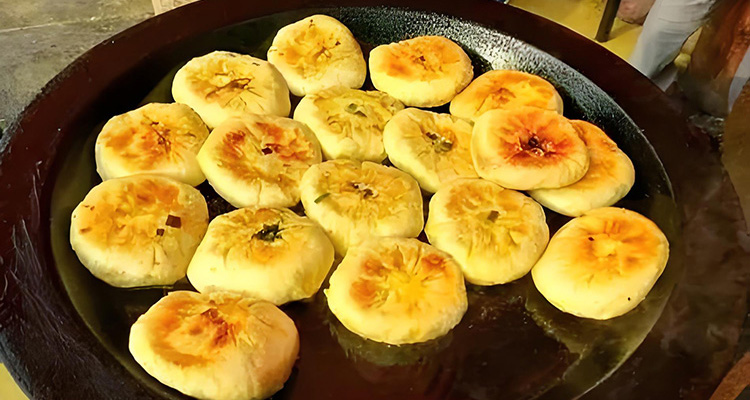Guichi Xiaoba: Chizhou’s Crispy Morning Treasure
1. Origin and History: From Rural Wisdom to Breakfast Icon
Guichi Xiaoba traces its roots to the agricultural life of Chizhou, Anhui Province. In the local dialect, “ba” refers to flat cakes made from rice or wheat. Farmers turned staple grains into a portable, filling breakfast by fermenting dough, stuffing it with preserved vegetables or fresh produce, and pan-frying the cakes for a convenient, energy-rich meal. Over generations, simple home cooking evolved into the refined, beloved Guichi Xiaoba sold at breakfast stalls across the city—an enduring symbol of Chizhou’s culinary heritage.
2. Cultural Significance: A Morning Social Hub and Symbol of Home
Eating Xiaoba in Chizhou is more than breakfast—it’s a social ritual. Before dawn, neighborhood stalls buzz with conversation as locals greet each other and wait for the satisfying clang of the spatula. For residents, Xiaoba is the savory kickoff to the day; for those who’ve left home, its flavor evokes fond memories. Guichi Xiaoba connects people, preserves local rhythms, and carries the warm, everyday ambience unique to Chizhou.

3. Ingredients and Flavor: Crispy Outside, Soft Inside, Fillings Galore
A well-made Guichi Xiaoba balances texture and flavor. The outer dough, made from traditionally fermented wheat flour, is hand-kneaded to give elasticity and a subtle wheat fragrance. Pan-frying at precise oil temperature creates a golden, crispy crust, while the inner layer remains soft and slightly chewy.
Popular fillings include:
- Pickled vegetables: salted mustard greens and local preserved greens for tangy, savory notes.
- Green beans: chopped and lightly stir-fried for a fresh, garden-like taste.
- Shredded radish: sweet and crisp, adding contrast.
- Vermicelli and minced pork: glass noodles absorb meaty umami, combined with minced pork for richness—ideal for meat lovers.
Each filling melds with the soft dough for a satisfying savory-crispy harmony.
4. The Making Process: The Warmth of Traditional Craftsmanship
Watching a master make Xiaoba is like seeing a culinary performance. Fermented dough is rolled into logs, divided evenly, flattened, then filled with a generous spoonful of stuffing. The dough is folded, sealed, and pressed into a flat round. The cakes are fried in a shallow pan until both sides are golden brown, releasing an inviting aroma. This hands-on technique—perfected over years—produces textures and flavors that mass-produced versions cannot match.

5. Tasting Guide and Traveler Tips: Eat Like a Local
For the best experience:
- Eat hot: Fresh from the pan is peak flavor—the crust is crisp and the filling steamy.
- Pairings: Combine with congee, soy milk, or savory tofu pudding for a balanced breakfast.
- Sampler option: Try a variety of fillings—pickled vegetables for authenticity, vermicelli and pork for richness.
- Where to go: Choose busy morning stalls or family-run shops—high turnover ensures freshness.
- Etiquette: Xiaoba is often wrapped to go; locals eat standing at the stall or enjoy a riverside breakfast.
6. Why Travelers Should Try It
Guichi Xiaoba offers more than flavor—it’s a taste of everyday life in Chizhou. Sharing a hot Xiaoba at a busy stall allows you to experience local rhythms, chat with vendors, and taste a dish that has nourished generations. For foodies and travelers seeking authentic street food, Guichi Xiaoba is a small but unforgettable culinary moment in Anhui.


